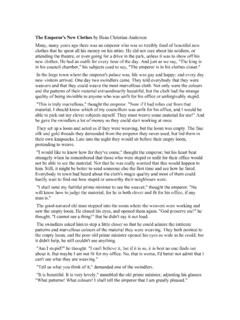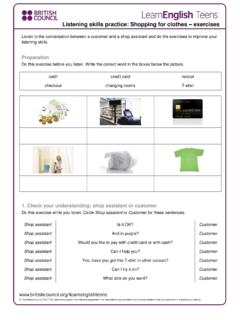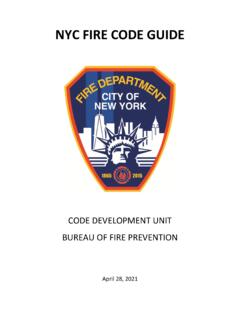Transcription of FRONT LOADING CLOTHES WASHER - Fisher & Paykel
1 FRONT LOADING . CLOTHES WASHER . WH1060P1 & WH1260P1 models INSTALLATION GUIDE / USER GUIDE. NZ AU. CONTENTS. Introduction 3. Safety and warnings 4. Installation instructions 5. Before your first wash 13. Safety features 14. Control panel 15. Detergent and softener dispenser 17. Getting started quickly 18. Wash cycles 19. Wash preparation 21. Customising wash cycle 24. Caring for your WASHER 27. Before you call for service 30. Fault codes 32. Troubleshooting 33. Manufacturer's Warranty 38. Customer Care 40. IMPORTANT! Registration SAVE THESE INSTRUCTIONS Register your product with us so we can The models shown in this User guide provide you with the best service possible. may not be available in all markets and are subject to change at any time. To register your product visit our website: For current details about model and specification availability in your country, go to our website or contact your local Fisher & Paykel dealer.
2 1. INTRODUCTION. Welcome Thank you for buying a Fisher & Paykel CLOTHES WASHER . We are proud of this WASHER and trust it will serve you well for many years. At Fisher & Paykel , we aim to provide innovative products that are simple to use, ergonomic and environment-friendly. Your WASHER has numerous wash cycles and options so you can perform every wash task with ease and the knowledge your CLOTHES are receiving the best possible care. Take the time to read these instructions carefully before you begin using your WASHER . Follow the instructions in this User guide to ensure you get the performance you expect from your WASHER and the best possible wash results. Keep this manual for future reference. We hope you enjoy your new WASHER . We have certainly enjoyed designing it for you. FRONT LOADING WASHER model 3.
3 SAFETY AND WARNINGS. ! WARNING! Electric Shock Hazard If you are using an extension cord or a portable electrical outlet device (eg multi-socket outlet box), ensure that it is positioned so that it does not come into contact with water or moisture. Failure to do so may result in death or electrical shock. IMPORTANT SAFETY INSTRUCTIONS. WARNING! When using your CLOTHES WASHER , follow basic precautions, including the following: This CLOTHES WASHER is not intended for use by persons (including children). with reduced physical, sensory or mental capabilities, or lack of experience and knowledge, unless they are supervised or given instructions on how to use the WASHER by someone responsible for their safety. The WASHER should only be used for washing and rinsing of textiles where this is indicated on the care label.
4 The door will be locked from the start of the cycle until the cycle is complete for safety reasons. It is possible to open the door during the cycle under certain conditions (refer to page 14). Never force the door open. Keep children away from the WASHER while it is in operation. Supervise children to ensure they do not play with the WASHER or climb inside the drum. Do not touch the glass part of the door during a cycle as the door can become hot. Do not open the detergent dispenser during the cycle as hot water may come out of it. The only user-removable parts of the WASHER are the inlet hose(s), detergent dispenser and the pump filter. No other parts are designed to be removed by anyone other than a Fisher & Paykel trained and supported service technician. When disposing of the WASHER , it is recommended that the door is removed to avoid children getting trapped inside, and that the electrical cable is cut off close to the WASHER .
5 Do not add petrol, dry-cleaning solvents, or other flammable or explosive substances to the wash water. These substances give off vapours that could ignite or explode. Do not wash articles that have been previously cleaned in, washed in, soaked in, or spotted with gasoline, dry-cleaning solvents, or other flammable or explosive substances as they give off vapours that could ignite or explode. A damaged power cord must be replaced by a Fisher & Paykel trained and supported service technician or similarly qualified person in order to avoid a hazard. Do not use the appliance until it has been repaired to avoid a risk of electric shock. 4. INSTALLATION INSTRUCTIONS. Accessories Check if you received the following accessories with your Fisher & Paykel WASHER . You will find them inside the drum or attached to the packaging.
6 2 x Inlet hose(s). 1 x Inlet valve cap 1 x Drain hose guide 1 x Installation guide and User guide 1 x Spanner 1 x Installation leaflet (attached to the top of the WASHER ). Unpacking To ensure the best performance from your new WASHER follow the instructions below. Removing the packaging 1 Remove the outer packaging (including the expanded polystyrene packer and plastic wrapping). All packaging must be removed prior to use. Ensure these materials are kept out of reach of children. Note: a small amount of water may be seen inside the packaging and inside the WASHER . This is the result of factory testing and is normal. 2 Tilt the machine backwards and walk' it off the base one foot at a time. Not doing so may cause damage to your floor and WASHER . 3 Remove all packaging and accessories from inside the drum.
7 Removing transit safety bolts The CLOTHES WASHER is fitted with transit safety bolts at the rear to avoid possible damage to the interior during transportation. IMPORTANT! The transit bolts MUST be removed prior to operation of the machine. Failure to remove these will result in damage to the machine. Note: the transit bolts MUST be removed in order to use the power cord. To remove the bolts 1 Use a spanner or socket to unscrew and remove all 4 transit bolts at the back of the WASHER (A). 2 Pull the black rubber grommets to remove the bolt, grommet and white plastic spacers from the machine (B). Retain these for future use. A. B. Removing the transit safety bolts 5. INSTALLATION INSTRUCTIONS. 3 Detach the drain hose from the plastic clasp, and remove the clasps on the side of the transit braces. Removing the drain hose 4 Remove the 10 transit brace screws from the left and right sides, and near the centre of the top brace (refer to C).
8 5 Remove the braces (refer to D). Keep the braces and screws for future use. C D. Removing the transit brace screws Removing the braces 6 Pull out the two transit rods located below the two lower transit bolt holes and retain for E. future use (refer to E). Removing the transit rods F. 7 Remove the yellow safety clip from the power cord. 8 Cover the transit bolt holes with the plastic plugs (provided). Push to clip into place (refer to F). Covering bolt holes with plastic plugs 6. INSTALLATION INSTRUCTIONS. Product dimensions C. E. A D. Wall B. FRONT VIEW TOP VIEW. PRODUCT DIMENSIONS mm A Overall height of product 850. B Overall width of product 600. C Overall depth of product (including dial and door when closed) 665. D Depth with door open 1110. E Minimum door clearance to adjacent wall 340. Standpipe or spigot height 600 1000.
9 MAXIMUM CAPACITY kg WH1060P1 10. WH1260P1 12. Note: the exact height of your WASHER is dependent on how far the feet are extended from the base of the machine. The space where you install your WASHER needs to be at least 40mm wider and 20mm deeper than its dimensions. Electrical supply: 220 240V, 50Hz sinusoidal, minimum 10A. Inlet water static pressure: Max. 1 MPa (150psi), Min. 30kPa ( ). Inlet water flow rate at tap: Min. 6 litres/min. 7. INSTALLATION INSTRUCTIONS. Location IMPORTANT! Install the machine on a solid and level floor surface ensuring it has at least 20mm clearance on each side. The WASHER must not be installed on any soft or textured floor coverings (eg carpet, rugs). Note: This machine must not be installed and operated on a plinth. Levelling the WASHER IMPORTANT. Level the washing machine to ensure good spin performance, and to minimise noise, vibrations and wear and tear on the WASHER .
10 1 Before positioning the WASHER in its final position, check that it is level, FRONT to back and side to side. 2 Adjust the WASHER into its final position (we suggest a minimum clearance of 20mm each side). 3 Use a spirit level to check that the WASHER is correctly level. If needed, pull the WASHER out. Loosen the lock nut using the spanner provided and wind the feet up or down to correctly level the machine. 4 Using the spanner provided, tighten the lock nuts against Locking the feet the base of the WASHER to lock the feet in position. Connecting to the water supply Inlet hoses IMPORTANT! Use new hose sets provided with the WASHER to connect the WASHER to the water mains. Old hose sets should not be re-used. We recommend the inlet hoses are changed every 5 years. WARNING: Failure to do so may result in a flood and damage to property.

















